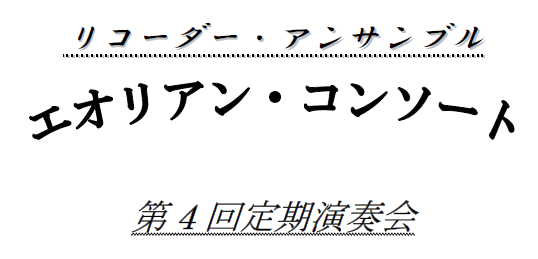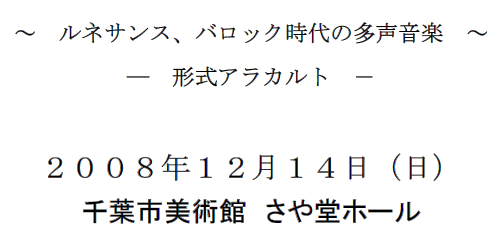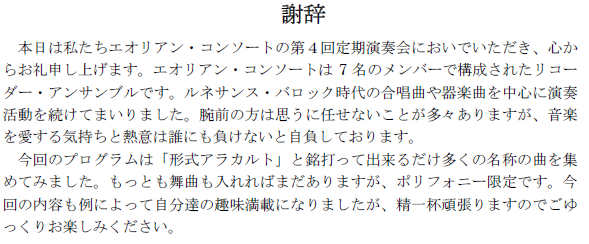Recorder ensemble
Aeolian Consort
The fourth regular Consert
--- Polyphony Music of the Renaissance and Baroque Periods ---
--- Forms a la carte. ---
(2008) / December /14 (Sun)
Chiba City Museum of Art, Sayado Hall
Acknowledgements
Thank you very much for coming to our fourth annual concert today. The Aeolian Consort is a recorder ensemble composed of seven members. We have been performing mainly choral and instrumental music from the Renaissance and Baroque periods. Although we are not always as good as we would like to be, we are confident that our love and enthusiasm for music are second to none.
This year's program is titled "Forms a la carte," and I have gathered together as many pieces as possible under different names. There are many more if you include dances, but we have limited ourselves to polyphony. As usual, the contents of this year's program are full of our own tastes, but we will do our best, so please enjoy it at your leisure.
~ Forms a la carte ~
I have used the word "form" in the name of "formality," but it is meant to indicate that we should have a variety of names. It is sometimes the same name but a different form, and sometimes a different name but the same form, so it can be confusing. Let me introduce the items that will appear today.
First, let's look at vocal music.
Cantata is one name by itself, but it also includes various forms of music. The content varies considerably from period to period, and Bach's works alone vary widely.
Chorales can be simple four-part chorales or chorale choruses that expand the scale and even introduce new themes. This is limited to the Lutheran school.
Arias are solo pieces. There are also recitative and others, but we will not cover them today.
The Mass includes several pieces, but the overall structure is largely fixed.
Motet is the name for all independent religious music, so it covers a wide range of periods and content. It can be seen as exclusively Catholic.
Instrumental and keyboard pieces have fairly common names.
There are two types of canzons: those divided into several parts and those that are a single piece.
Capriccios are almost identical to canzons, and it is hard to tell the difference. The only difference is the mood of the subject matter.
Recercar has various spellings. While the movements are simple, the subject matter is complex.
Fantasy is also spelled differently. Since it is the most widely used name, its contents vary widely. The English consort in particular is a single-minded group.
Tiento is the monopoly of the Iberian Peninsula. There are other names as well, but Tiento is the dominant one. Inevitably, the contents vary from one country to another.
In Nomine is only found in England and uses a specific melody, so it is a little different from a mere name.
Is a fugue a name or a form? Which is it?
That's all for today, but of course there are many more. For variations, there are La Folie, Chaconne, Passacaglia, Verso, etc. For dances, there are Pavin, Corrente, Gaillarde ......, Toccata for keyboard only, and so on. There are a lot of them.
It was first performed in November 1724, in Bach's second year in Leipzig. It is classified as a chorale cantata because it uses a chorale for the opening chorus. The original aria is sung by a bass soloist, accompanied by three oboes and bass continuo. I have arranged it with the soloist as a soprano. The last is a simple four-voice version of the chorale that appeared in the opening chorus.
Maschera was a composer from Venice. This canzon is not divided into several units, but is composed as a whole. The canzon is characterized by its light rhythm, and the homophonic succession of the opening theme is used in many pieces as a promise.
Battiferri was a composer and organist who worked in Urbino and Ferrara, Italy. The previous piece was a triple fugue, but this time there is only one theme. Instead, the antiphonal form of the theme (note form upside down) and the expanded form (note value lengthened) appear, and the piece is complex with the use of stretta (simultaneous layering of the theme). Ricercar has many works with elaborate content.
Frescobaldi was a native of Ferrara and a major composer of keyboard music. His capriccio is a combination of several units, but unlike a canzon, his choice of subject matter is more elaborate. In the case of this piece, "Fiamenga" is the name of a place in central Italy, and the theme is modeled after a dance piece originating from this place. The entire piece is composed of seven parts, with four and three beats alternating.
In Spain, there is a field called glossado, which is the embellishment of a pre-existing work. The two pieces featured today are from a collection published at the time by a man named Hernestroza, and coincidentally use the same parts of the same Mass by Josquin. Cabezon's is No. 12 and Parello's is No. 27. I made the set because of the occasion. The original music is treated quite freely, so they do not correspond perfectly, but you can clearly hear that they are the same piece of music.
Cabanilles is one of the leading keyboard music composers of 17th century Spain. Although they share the same tiento, they differ in period and content from Cabezon and Parero. In the case of Cabanilles, there are more detailed distinctions such as "ple" and "de falsas". This piece is "leno" (linear) and counterpoint-dominated. It begins with a slow presentation of the theme (the response is in antiphonal form), then gradually increases in pitch, and finally breaks into 12/8 time. The complex rhythmic intertwining may be a feature of this piece.
Buxtehude is famous for his organ music, but he also left many vocal pieces. But only chorus is rare. One might think, "Lutheran, but a mass?" But the Kyrie and Gloria are sometimes used. The word "brevis" means "short," so it is translated as "Little Mass". The composition of this piece consists of three parts for the chirier and two parts for the gloria. It is noteworthy that the gloria features the cruciform form, which is known to have been used frequently by Bach. It is known that Bach used it a lot, but it was a little surprising that Buxtehude had already used it.
Contrapunctus 8 is a triple fugue in three voices. It is the longest fugue in "Die Kunst der Fuge" except for the unfinished fugue, and since it is performed by three voices, the range is wide and there are no breaks, so I have not had a chance to play it in the performance. This time, since there were no other candidates for three voices, I decided to give it a try. The basic theme is not so easy to find. It appears in the 94th measure out of 188 measures, exactly in the middle of the piece.
The Aeolian Consort always adds one In Nomine to its concerts. We decided to try again because we were not satisfied with the performance of this piece at the last concert. 7-nominee pieces are few in number, so we cannot waste them. It is a whimsical piece with no motive, and the harmony changes somehow. Alto 1 (using soprano) is in charge of the constant melody.
John Jenkins was one of the leading English consort composers of the 17th century, and is considered an important link between Gibbons and Lawes of the late 16th century and Purcell of the late 17th century. His fantasias come in a variety of forms, but those with a single theme are the toughest and easiest to summarize, such as the four-voice No. 9. The theme is reminiscent of the canzon of the past, but the content can only be described as a fugue. Stretta and extended themes are Jenkins' specialty.
This is a motet for the feast of the Purification of the Blessed Virgin Mary (Purificatione beata Mariæ virginis February 2). I am not saying that Mary is black. The lyrics are from the Old Testament Song of Songs 1-5 and below. It is also used in Monteverdi's "Evening Prayer of the Blessed Virgin Mary" (No. 3), so it seems to have a connection with Mary. Victoria spent his prime years in Italy, and this piece was probably performed in Rome.
The last piece was still Bach. The Fantasia was duplicated, but the name "fugue" was not mentioned, so I decided to call it okay. The Fantasia is a diversion from Vivaldi's ritornello form. Tutti and trios appear alternately. The power of the grand concerto is one of the most impressive in Bach's harpsichord music. The fugue on the other hand is a robust double fugue. Two contrasting themes, the first full of emotion and the second chromatic, overlap beautifully. From the appearance of the second theme, the storm of changing tones will be very exciting. I hope you can get through it safely...
(PS) All the songs we will be playing are available on our website in sheet music, MP3s, and MIDIs. If you are interested If you are interested, please take a look.
By this time, I had a wealth of my own compositions, so I stopped using commercial sheet music and arrangements by others.
















